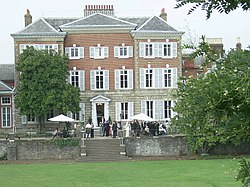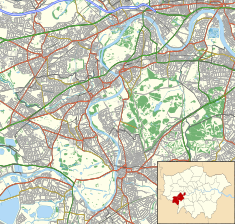
Kew is a district in the London Borough of Richmond upon Thames. Its population at the 2011 census was 11,436. Kew is the location of the Royal Botanic Gardens, now a World Heritage Site, which includes Kew Palace. Kew is also the home of important historical documents such as Domesday Book, which is held at The National Archives.

Twickenham is a suburban district in London, England. It is situated on the River Thames 9.9 miles (15.9 km) southwest of Charing Cross. Historically part of Middlesex, it has formed part of the London Borough of Richmond upon Thames since 1965, and the borough council's administrative headquarters are located in the area.

The London Borough of Richmond upon Thames in southwest London, England, forms part of Outer London and is the only London borough on both sides of the River Thames. It was created in 1965 when three smaller council areas amalgamated under the London Government Act 1963. It is governed by Richmond upon Thames London Borough Council and is divided into nineteen wards. The population is 198,019 and the major settlements are Barnes, East Sheen, Mortlake, Kew, Richmond, Twickenham, Teddington and Hampton.
Richmond is a town in south-west London, 8.2 miles (13.2 km) west-southwest of Charing Cross. It stands on the River Thames, and features many parks and open spaces, including Richmond Park, and many protected conservation areas, which include much of Richmond Hill. A specific Act of Parliament protects the scenic view of the River Thames from Richmond.

St Margarets is an affluent suburb and neighbourhood in the London Borough of Richmond upon Thames, about 9 miles (14 km) west-southwest of central London. It is bounded by the Thames Tideway to the north-east, and the River Crane to the north-west and north where the land tapers between these rivers. Land and buildings closer to Richmond Bridge than the eponymous railway station are, traditionally distinctly, known as East Twickenham. Both places go by their post town and traditional parish, Twickenham quite often; in the 19th century the south of St Margarets was marked on maps as Twickenham Park.
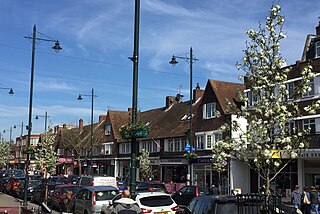
Whitton is an area of the London Borough of Richmond upon Thames, England. Historically, it was the north-western part of Twickenham manor, bounded by the River Crane and the Duke of Northumberland's River.

The Naked Ladies are a Grade II listed statue complex on a rockery and water cascade in the gardens of York House, Twickenham, in the London Borough of Richmond upon Thames, England. The larger than human size statues depict eight Oceanids and a pair of aquatic horses. They were carved in the fin de siècle style from white Carrara marble and probably came from Italy in the late nineteenth century or very early twentieth century. Originally they were part of a larger set of statues that was subdivided after the suicide of the initial purchaser.

Teddington is an affluent suburb of London in the London Borough of Richmond upon Thames. Historically an ancient parish in the county of Middlesex and situated close to the border with Surrey, the district became part of Greater London in 1965. In 2021, The Sunday Times named Teddington as the best place to live in London.

Richmond upon Thames London Borough Council is the local authority for the London Borough of Richmond upon Thames in Greater London, England. It is a London borough council, one of 32 in London, the United Kingdom capital. Richmond upon Thames is divided into 18 wards and elections for all Council seats in the borough are held every four years. The most recent election was in 2022 when the Liberal Democrats, led by Gareth Roberts, retained overall majority control of the council for a second consecutive term.

Orleans House was a Palladian villa built by the architect John James in 1710 near the Thames at Twickenham, England, for the politician and diplomat James Johnston. It was subsequently named after the Duc d'Orléans who stayed there in the early 19th century. By the early 20th century it was derelict and in 1926 it was mostly demolished. However, parts of the property, including a baroque octagonal room designed by architect James Gibbs, were preserved. The octagon room and its service wing are listed Grade I by Historic England and, together, with a converted stable block, are now the Orleans House Gallery, a gallery of art relating to the London Borough of Richmond upon Thames and neighbouring areas of London.
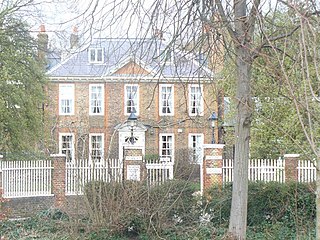
Douglas House is a Grade II* listed early 18th-century Queen Anne-style house in Petersham in the London Borough of Richmond upon Thames. It is now the site of the German School London.
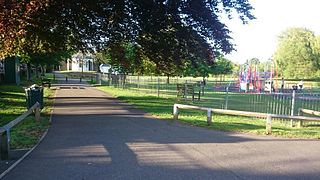
Radnor Gardens is a small public riverside garden and recreation ground in Strawberry Hill, south of Twickenham in the London Borough of Richmond upon Thames, offering picturesque views. It has a First World War memorial, a grass area, a bowling green and a children's playground.
Cross Deep House was an 18th-century house, on the banks of the River Thames in Cross Deep, Strawberry Hill, 0.5 miles (0.80 km) south of Twickenham town centre. It was demolished in 1906 and the remains of its grounds form part of present-day Radnor Gardens.

Richmond Cemetery is a cemetery on Lower Grove Road in Richmond in the London Borough of Richmond upon Thames, England. The cemetery opened in 1786 on a plot of land granted by an Act of Parliament the previous year. The cemetery has been expanded several times and now occupies a 15-acre (6-hectare) site which, prior to the expansion of London, was a rural area of Surrey. It is bounded to the east by Richmond Park and to the north by East Sheen Cemetery, with which it is now contiguous and whose chapel is used for services by both cemeteries. Richmond cemetery originally contained two chapels—one Anglican and one Nonconformist—both built in the Gothic revival style, but both are now privately owned and the Nonconformist chapel today falls outside the cemetery walls after a redrawing of its boundaries.
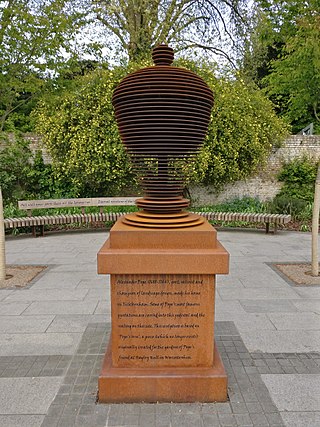
Pope's Urn, on Champion's Wharf at Twickenham riverside in the London Borough of Richmond upon Thames, is a contemporary piece of public art inspired by the poetry of 18th-century Twickenham resident Alexander Pope, who is buried in the parish church that overlooks the wharf. It consists of a stylised urn on a pedestal, both made in corten steel and standing just over eight-foot high, surrounded by wooden benches inscribed with aphorisms written by Pope. It was commissioned to celebrate the 2015 Rugby World Cup, for which Twickenham Stadium was one of the venues, and was opened in a ceremony on 21 September 2015.

The Old Town Hall, Richmond on Whittaker Avenue in Richmond, London is a former municipal building which from 1893 to 1965 served as the town hall for the Municipal Borough of Richmond.

Twickenham War Memorial, in Radnor Gardens, Twickenham, London, commemorates the men of the district of Twickenham who died in the First World War. After 1945, the memorial was updated to recognise casualties from the Second World War. The memorial was commissioned by Twickenham Urban District Council in 1921. It was designed by the sculptor Mortimer Brown, and is Brown's only significant public work. The memorial is unusual for its representation of a jubilant soldier returning home. It became a Grade II* listed structure in 2017.
